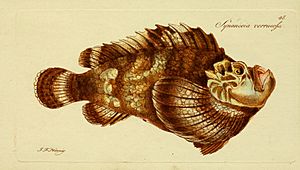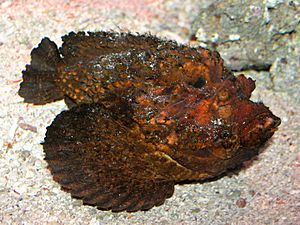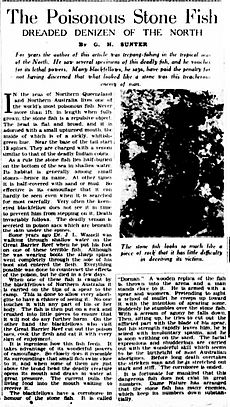Synanceia facts for kids
Quick facts for kids Synanceia |
|
|---|---|
 |
|
| Type species Synanceia verrucosa, 1801 illustration | |
| Scientific classification |
|
| Kingdom: | Animalia |
| Phylum: | Chordata |
| Class: | Actinopterygii |
| Order: | Scorpaeniformes |
| Family: | Synanceiidae |
| Genus: | Synanceia Bloch and J. G. Schneider, 1801 |
Synanceia is a group of fish often called stonefish. They are known for being very venomous. In fact, they are the most venomous fish known in the world! Stonefish live in the coastal areas of the Indo-Pacific Ocean. Their venom can be dangerous, and even deadly, to humans if not treated quickly.
Contents
What are Stonefish?
The most well-known type of stonefish is Synanceia verrucosa. This group also includes other species like Synanceia horrida. Sometimes, you might see the name Synanceja used, but this is just a different spelling for the same group of fish.
Types of Stonefish
Here are some of the different kinds of stonefish:
- Synanceia alula (Midget stonefish): Found from the northern Indian Ocean to the Solomon Islands.
- Synanceia horrida (Estuarine stonefish): Lives from India to China, the Philippines, Papua New Guinea, Australia, and Vanuatu.
- Synanceia nana (Red Sea stonefish): Found in the Red Sea and Persian Gulf.
- Synanceia platyrhyncha: Lives in Indonesia.
- Synanceia verrucosa (Stonefish): Found in the Red Sea and the Indo-Pacific region.
Where Stonefish Live and How They Look
Stonefish mostly live in the ocean. However, some types can also be found in rivers. These fish have powerful neurotoxins. These toxins are made in glands at the bottom of their sharp, needle-like dorsal fin spines. These spines stick up when the fish feels bothered or threatened.
The name "stonefish" comes from their amazing camouflage. They are grey and spotted, looking just like a rock or coral. This makes them very hard to see! Swimmers might not notice them and accidentally step on them. When this happens, the stonefish can inject venom. The amount of venom depends on how much pressure is put on the fish.
A study from 2018 showed something cool about stonefish. They can also push out a sharp, special spine called a lachrymal saber. This is an extra way for them to defend themselves. The venom from stonefish is very strong. It can damage cells in the body. It can also lower the number of white blood cells, which fight off sickness. This can lead to infections even after the wound is treated.
What to Do if Stung by a Stonefish
Stonefish stings are extremely painful. They can be very serious if not treated. The two main ways to treat a sting are using heat and antivenom.
Applying hot water (no hotter than 45 °C (113 °F)) to the stung area helps. The heat breaks down the stonefish venom. This causes less pain for the person who was stung. Antivenom is used for more serious stings. Some beaches in Australia even have vinegar available. People say it helps lessen the pain, but hot water and antivenom are the main treatments.
Stonefish Stings in Australia
Stonefish are among the most venomous fish in the world. Their stings can be life-threatening if not treated. Most stings happen when someone steps on the fish. This pushes venom into their foot. It's less common for a stonefish to sting if it's picked up.
You can get stung by a stonefish even on the beach. This is because stonefish can live out of water for up to 24 hours! They are very hard to spot because they look so much like rocks or coral. Stonefish antivenom is one of the most used antivenoms in Australia.
Some Indigenous Australians have special dances called corroborees. These dances sometimes show what happens when someone steps on a stonefish. The Aboriginal people of Northern Australia and the Great Barrier Reef know how to prepare stonefish safely for eating. This helps them avoid getting poisoned.
The amount of antivenom given depends on how many times the stonefish spines punctured the skin.
How Often Do Stings Happen?
Between July 1989 and June 1990, 25 cases of stonefish antivenom use were reported in Australia. Most of these were in Queensland. In 2008, the Queensland Poisons Information System received 14 calls about stonefish poisonings.
Stonefish as Food
Stonefish can be eaten by humans if they are prepared correctly. The venom is made of protein. This protein breaks down quickly when heated. If eaten raw as part of sashimi, the fish becomes harmless just by removing the dorsal fins. These fins are where most of the venom is found.
Stonefish are considered a special food in many parts of Asia. This includes southern Japan, southern Fujian, Guangdong in China, and Hong Kong. In areas where people speak Hokkien, they are thought to be good for health. The meat of the stonefish is white, firm, and sweet. Even the skin can be eaten! They are usually cooked with ginger to make a clear soup. Sometimes, they are served raw as sashimi.
See also
 In Spanish: Peces piedra para niños
In Spanish: Peces piedra para niños



